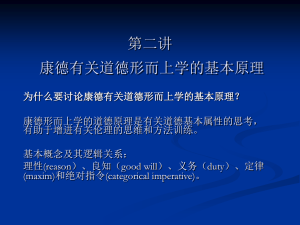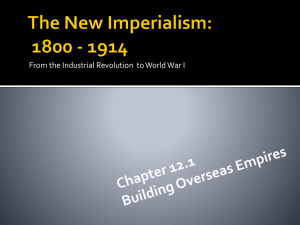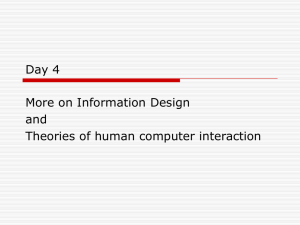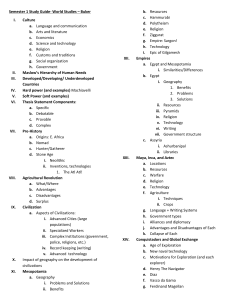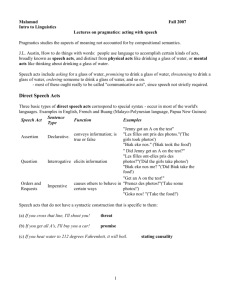Mergers & Acquisitions (MBAF/H 624)
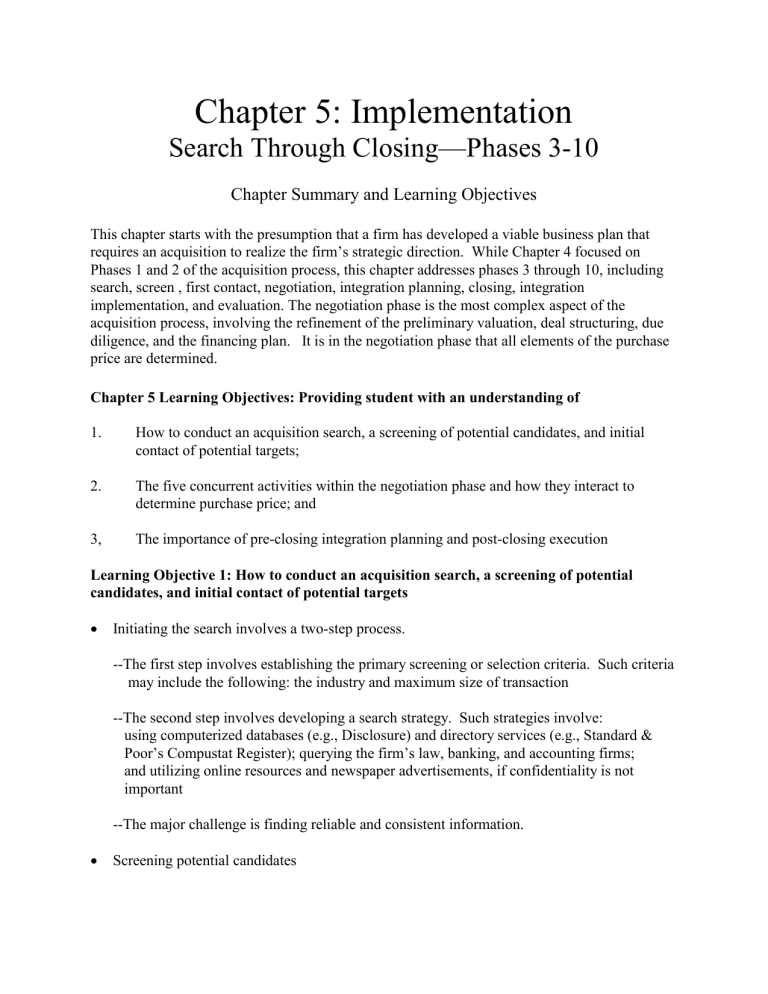
Chapter 5: Implementation
Search Through Closing—Phases 3-10
Chapter Summary and Learning Objectives
This chapter starts with the presumption that a firm has developed a viable business plan that requires an acquisition to realize the firm’s strategic direction. While Chapter 4 focused on
Phases 1 and 2 of the acquisition process, this chapter addresses phases 3 through 10, including search, screen , first contact, negotiation, integration planning, closing, integration implementation, and evaluation. The negotiation phase is the most complex aspect of the acquisition process, involving the refinement of the preliminary valuation, deal structuring, due diligence, and the financing plan. It is in the negotiation phase that all elements of the purchase price are determined.
Chapter 5 Learning Objectives: Providing student with an understanding of
1.
How to conduct an acquisition search, a screening of potential candidates, and initial contact of potential targets;
2.
The five concurrent activities within the negotiation phase and how they interact to determine purchase price; and
3, The importance of pre-closing integration planning and post-closing execution
Learning Objective 1: How to conduct an acquisition search, a screening of potential candidates, and initial contact of potential targets
Initiating the search involves a two-step process.
--The first step involves establishing the primary screening or selection criteria. Such criteria
may include the following: the industry and maximum size of transaction
--The second step involves developing a search strategy. Such strategies involve:
using computerized databases (e.g., Disclosure) and directory services (e.g., Standard &
Poor’s Compustat Register); querying the firm’s law, banking, and accounting firms;
and utilizing online resources and newspaper advertisements, if confidentiality is not
important
--The major challenge is finding reliable and consistent information.
Screening potential candidates
--Involves shortening the list of candidates identified as a result of the search process by
adding more criteria
--Such criteria may include market share, product line, profitability, and degree of leverage
Initiating first contact
--The approach taken depends on size of firm and the timeframe of the acquirer.
--If time permits, building relationships as high in the organization as possible is an excellent
prelude to inquiring about the potential target’s interest in being acquired. However, if time
is critical, the direct approach is necessary.
--Small firms (<$25 million in revenue) may be approached directly and informally.
--Medium sized firms (between $25 and $100 million) are often contacted through an
intermediary.
--Large, publicly traded firms should be contacted through an intermediary at the highest level
possible.
--Discussing value with the seller requires that the buyer have some notion of an initial
valuation of the potential target
--If the target is willing to exchange information, a number of documents need to be
negotiated, including a confidentiality agreement, term sheet, or letter of intent
Learning Objective 2: The four concurrent activities within the negotiation phase and how they interact to determine purchase price.
Refining valuation involves updating initial valuation based on new information.
Deal structuring entails satisfying the highest priority needs of all parties involved.
Due diligence is the process of conducting a detailed review of the seller’s records, personnel, and facilities. The objective is to validate key assumptions underlying the initial valuation, identify sources and destroyers of value, and to look for any “fatal flaw” which could render the target firm unattractive to the potential buyer.
Developing the financing plan determines if the proposed transaction can be financed. It is the reality check in that it involves the evaluation of the proposal’s underlying assumptions by objective third parties (e.g., lenders and investors).
Learning Objective 3: The importance of pre-closing planning and post closing execution
Developing the integration plan includes identifying the key actions and understanding the key resources required to implement the integration of the businesses.
Closing entails gaining all necessary shareholder, regulatory, and third party consents, as well as completing the agreement of purchase and sale.
2
Post closing integration involves implementing effective communication plans, retaining key managers, identifying and funding immediate operating cash flow requirements, employing best practices of both firms, and addressing cultural issues.
Post-closing evaluation involves identifying what worked and what didn’t during the acquisition process and taking corrective actions as necessary to ensure that best practices are employed in future transactions.
An Example of a Business and Acquisition Plan: Maxim Acquires Dallas Semiconductor
1
(Note that this is a highly abbreviated version of a business and acquisition plans)
Background
Maxim Integrated Products, a leading producer of analog and mixed signal semiconductors, was running on all cylinders at the end of 2000. The company was expected to grow sales by nearly
43%, and earnings were expected to increase by 36% year over year. While 1999 – 2000 represented an exceptional year, success was nothing new to Maxim. Since 1995, sales had nearly doubled, and earnings were increasing at a steady 20% to 30% annual rate. Even in 1998, a down year for the industry as a whole, Maxim still managed to grow sales by 8% and earnings by 7%. Constant innovation, a hard driving, bottom line oriented CEO, and an ability to opportunistically enter new markets are the key drivers behind Maxim’s success. By introducing more new parts to the market than any other chip company, Maxim sought to out-maneuver rivals in being the first to enter every conceivable niche that offers the potential to earn above average margins.
Founded in 1982 by CEO Jack Gifford, Maxim has never engaged in an acquisition of an entire operating company. Instead, Jack, a serial entrepreneur, has always preferred organic growth.
During 2000, Jack re-affirmed his plans for Maxim to become a $2.5B company by the year 2005 through organic growth. However, by the end of the year, Jack had started to reconsider his stance on making an acquisition. Maxim’s growth was starting to become constrained by the scarcity of experienced analog engineers, which limited access to several new products areas (e.g. telecommunications chipsets). The thought of acquiring a competitor to gain access to engineering talent and new product lines had some appeal.
At the end of 2000, a unique opportunity presented itself to Maxim. Vincent Protho, the CEO of competitor Dallas Semiconductor, had died suddenly from a heart attack in November of 2000.
Dallas was suddenly adrift and in desperate need of capable leadership. No internal candidates had emerged as being qualified enough to run Dallas, and the board was getting nervous.
Finding a capable replacement outside the company would be a long and difficult process – there are very few people with the skills necessary to run a half billion dollar, global semiconductor company.
An acquisition made sense for several reasons. Dallas has a strong, but under-promoted product line relative to Maxim’s, with very little overlap. In addition, Dallas’s productivity in terms of new product development is far less than half that of Maxim’s despite having a comparable
3
number of engineers. Lastly, Dallas’s inefficient cost structure could benefit from the application of Maxim’s, “low cost producer” mentality; Maxim’s net margins are 32% after tax compared with 18% for Dallas. During December of 2000, Maxim decided to approach Dallas’s board with an acquisition proposal. Maxim’s business plan and acquisition plans are outlined below.
Business Plan
Industry/Market Definition
Maxim competes in the global semiconductor market. The size of this highly cyclical market during 2000 was $204 billion. Early 2000 marked the top of an uncommonly long 5-year “up” cycle that started in 1995. Normally, the semiconductor industry operates on a 3-year cycle. A typical three-year cycle is characterized by two years of double-digit growth followed by six months of contraction and then six months of flat or slowly recovering sales. The top of a cycle is characterized by excess capacity brought on by a drop in unit demand due to macroeconomic factors. Excess capacity causes inventories to build, prices to fall, and per unit fixed costs to rise.
The overall semiconductor market has two major segments, digital (e.g., computer memory devices) and mixed signal/ analog (e.g., devices used to link analog and digital devices) .
Maxim competes in the $$30 billion analog/mixed signal segment with competitors such as National
Semiconductor ($1.6 billion) and Texas Instruments ($8 billion). A common example of an application of analog and mixed signal semiconductors is the conversion of the digital information encoded on a CD to an analog signal before it can be amplified into a sound that can be heard. Conversely, an analog audio signal needs to be converted to digital information (“bits and bytes”) before being burned onto a CD or saved as an MP3 file. To address these needs,
Maxim and its competitors make semiconductor devices called “digital to analog converters” and
“analog to digital converters.”
Unlike the market for digital devices, the end user market for analog and mixed signal chips is extremely fragmented. Maxim produces analog and mixed signal chips for numerous customers in many diverse market segments including instrumentation, industrial controls, data processing, communications, military, video, medical, automotive, and consumer. The largest segments for
Maxim in terms of their share of total revenue are communications (30%-35%), data processing
& consumer (25%-30%), and industrial control (30-35%). The remaining markets comprise the remaining 5%-10%. In total, the analog and mixed signal segment is expected to grow faster than the overall semiconductor market by 5% to 10% annually. The fastest growing segments are anticipated to be communications and data processing.
External analysis
The dynamics of the analog/mixed signal segment of the semiconductor market analyzed in terms of customers, suppliers, competitors, potential entrants, and substitute products and services.
Customers
4
Customers can include OEMs who design electronic equipment (e.g. Cisco), contract manufacturers who assemble electronic equipment for OEMs (e.g. Solectron), and distributors who re-sell products to OEMs and contract manufacturers (e.g. Arrow Electronics). Customers have substantial power when they are large and buy in volume, the supplier’s product is relatively undifferentiated and switching is easy, customers’ purchases represent a substantial portion of a supplier’s total revenue, and customers can easily integrate backward. Based on these criteria,
Maxim is in a relatively strong position relative to their customers. Although Maxim has several large customers who buy in substantial volume (e.g. Samsung, Cisco), over 80% of Maxim’s products are differentiated and proprietary. As a result, switching to a competitor is expensive and time consuming, even for large and powerful customers
Suppliers
Maxim’s suppliers include companies who provide raw materials and equipment for manufacturing semiconductor devices. Examples of raw materials to produce semiconductors include silicon wafers, chemicals for etching circuits on the wafers, and materials related to packaging the processed silicon into finished electronic devices (e.g. gold bond wires, lead frames, and plastic molding compounds). Equipment used in semiconductor production includes diffusion chambers, chemical etchers, and sophisticated automated test equipment. Suppliers in a given industry are powerful when they are few in number and highly concentrated relative to the industry that they serve, the product supplied is highly differentiated with few substitutes, it’s possible to forward integrate into a customer’s business, and if the supplier is highly diversified such that no customer represents a substantial portion of their revenue. On the “raw” material side, Maxim’s suppliers are weak. Hundreds of companies produce raw silicon wafers, chemical, and device packaging materials. However, the suppliers of the sophisticated equipment used to produce semiconductors are relatively powerful. There are only four significant domestic producers of equipment such as ion diffusers, etchers, and testers. Applied Materials, KLA-
Tencor, Novellus, and Teradyne dominate the semiconductor equipment industry.
Competitors
Maxim’s competitors include Texas Instruments ($8B), ST Microelectronics ($6B), National
Semiconductor ($1.6B), Linear Technology ($500M), Analog Devices ($1.7B), Micrel ($200M), and Dallas Semiconductor ($550M). Intense competition occurs when there are many competitors of similar size and power, market share is at a premium due to a stagnant or declining industry, the product or service is perishable or time sensitive, fixed costs are high, capacity is expensive to add, and barriers to exit are significant. Maxim is in a highly competitive industry. The five competitors are of similar size and power, and there are many other niche competitors, who have some overlap with at least one of Maxim’s product lines. In addition, fixed costs associated with semiconductor manufacturing are very high due to the need for highly specialized equipment and customized factories (e.g. clean rooms). Adding capacity is expensive and difficult to bring online in small increments. Exiting the industry is prohibitively expensive since customized factories and high tech manufacturing equipment that rapidly becomes obsolete have very little liquidation or resale value. However, despite these factors that drive competitive
5
intensity, the semiconductor industry is expanding rapidly, and new market segments are constantly emerging. As a result, despite intense competition, Maxim is able to maintain doubledigit growth rates and 70% gross margins through innovation and cost containment.
Potential Entrants
To offset high fixed costs, competitors must achieve high production volumes to take advantage of economies of scale. New entrants will have trouble achieving the necessary scale in a short period for two reasons: limited brand recognition and difficulty in gaining access to distribution channels currently committed to other suppliers.
Substitute Products & Services
There are currently no viable substitutes capable of efficiently mimic both the form and function of integrated semiconductor chips. However, well-capitalized producers of digital semiconductors (e.g. Intel) are actively researching ways to cost effectively integrate certain analog functions into their microprocessor chipsets. In the future, microprocessors chipsets that incorporate traditionally analog functions could potentially be a viable substitute for certain classes of analog semiconductors.
Internal Analysis
Strengths
Maxim’s historical core competencies have been new product and process innovation and a culture focused on cost containment. The firm’s ability to innovate has resulted in a product offering that includes nearly 3000 unique parts to satisfy the exceptionally diverse needs of the highly fragmented analog/mixed signal semiconductor market. This is nearly 3 times the number of parts as their nearest competitor. The expansion of the product offering has historically provided the basis of new revenue generation. Amazingly, despite the volume of new parts introduced each year, Maxim has a strict non-obsolescence policy – once a new part is introduced, it is never retired. This policy is unique to Maxim, and it is a particularly strong selling point with customers who design products with long life cycles (e.g. military electronics).
Moreover, its strengths in the area of process innovation have resulted in the firm having developed a Silicon Germanium (“SiGe”) process for producing high frequency chips used in next generation wireless communications products. This gives Maxim control over 100% of the intellectual property involved in both the design and manufacture of such devices. Finally, an aggressive focus on cost control is deeply ingrained in the culture at Maxim. There are strict, written procedures that govern discretionary spending. In addition, employees are also expected to show creativity in finding ways to hold down costs. Goals and bonuses are structured to reward employees who show creativity in finding ways to contain costs without harming
Maxim’s business prospects. Maxim’s gross margins are routinely in the 70% range, and aftertax net margins are typically over 30%. By comparisons, most competitors have gross and net margins of approximately 50% and 20% respectively.
6
Weaknesses
Maxim’s key weaknesses are customer perception problems surrounding order fulfillment performance, marginal relationships with distributors, and lack of a succession plan for CEO
Jack Gifford. Due to the firm’s conservatism in adding capacity despite frenetic growth,
Maxim’s lead times extended well beyond those of its competitors during the mid-1990s.
Despite correcting the problem, the reputation that Maxim can’t deliver” is still pervasive among customers. Maxim’s relationships with their franchised distributors are marginal and can even be adversarial at times – this is due in large part to the razor thin markup that Maxim allows distribution to charge. Most semiconductor companies depend on their full service distributor partners to provide sales, marketing, and technical support to customers in addition to order fulfillment services. In exchange for these services, distributors are paid additional margin by the semiconductor supplier. However, Maxim has no value added programs with distributors – they use distribution strictly for order fulfillment purposes. As a result, the margin that Maxim pays to distributors is very low compared to their competitors. Finally, Maxim lacks an effective succession plan to replace its 65-year-old CEO, Jack Gifford, who has been the driving force behind the firm since its inception.
Opportunities & Threats
Maxim’s highly innovative culture provides a number of new opportunities for extending its proprietary products to meet numerous emerging market and product opportunities. The highly fragmented analog/mixed signal market is characterized by hundreds of niche product segments that quickly become saturated. Maxim’s ability to maintain consistently 70% gross margins is dependent on identifying emerging markets early and entering into them with highly proprietary products. As a product segment matures, Maxim moves on to the next market that offers better profit prospects. Key opportunities for analog semiconductors over the next five years will exist in niches within the following end equipment segments: high frequency communication, portable electronics, high-speed data communication, and transaction processing. In terms of product line expansion, key opportunities exist for Maxim in the following product areas: (1) real time clock
(“RTC”) chips for programmable thermostats, portable medical defibrillators, set top boxes, etc.;
(2) framers for telecommunications equipment that convert analog signals on a telephone line to into properly formatted digital bits and bytes for a telecom switch or router; (3) lithium battery monitor chips for portable electronics, and (4) mixed signal microcontrollers for use in set top boxes, point of sale terminals, and MP3 players.
Threats to Maxim’s continued growth and profitability come from three sources: a scarcity of analog design engineers, traditional competitors, and non-traditional competitors. Unlike their digital counterparts, analog engineers are in short supply. Few engineering schools offer a dedicated curriculum in analog engineering, and new graduates typically need an additional five years of careful mentoring before they can be productive on their own projects. As a result,
Maxim’s continued growth and profitability are severely threatened by a perpetual shortage of analog design engineers. In addition, Maxim’s traditional competitors have overlapping product
7
lines, common customers, and, in some cases, directly substitutable parts; they also are competing aggressively for scarce analog engineering resources. Finally, non-traditional competitors such as Intel Corporation are close to developing chip technology that could threaten
Maxim’s leadership position in producing chips for wireless networking.
Business Mission / Vision statement
Maxim’s mission statement is:
“…to continuously invent high-quality analog engineering solutions that add value to our customers' microprocessor-based electronics worldwide. We have consistently increased our stockholders' equity by meeting our cost and performance goals, minimizing time-to-market, and maximizing our engineering productivity.”
Financial Objectives
Revenue Growth: Maxim will become a $2.5B company by the year 2005.
Earnings Growth: Maintain historical earnings growth of 20% to 30% per year.
Price to Earnings: Reward shareholders by seeking to maintain a multiple of 40 times forward looking (i.e. 12 months) earnings
Gross Profit Margins: Maintain gross profit margins of 70%
Net Profit Margins: Maintain net profit margins of 30%
Non-Financial Objectives
Market share: Become the market share leader in all analog/mixed signal product categories that offer the opportunity to earn above average margins
Diversification: Seek to invent continuously new parts for new markets. Produce 20% more new parts each year than the previous year.
Quality: Shown continuous, annual improvements in the average failure in time (F.I.T.) rate, which is currently at 1.2. F.I.T. is a measure of the average number of failures per billion device hours.
Process Technology: As required, develop and refine new semiconductor process technologies that will enable efficient production of a broad line of state of the art analog and mixed signal chips.
Business Strategy
Maxim’s business strategy is a hybrid consisting of both a cost leadership and differentiation element. :Maxim seeks to contain costs through managing capacity utilization, tight inventory management practices, controlling discretionary overhead expenses, and highly targeted sales
8
activities. Maxim will achieve differentiation by offering proprietary products featuring unique electrical characteristics (e.g., feature sets, performance specifications, etc). Over 80% of these products are proprietary. Proprietary parts differentiate themselves from competitors’ products by offering unique electrical characteristics (e.g., feature sets, performance specifications, etc.) that allow customers to design electronic systems with fewer parts and complexity.
Implementation Strategy
Maxim seeks to implement its business strategy through a an acquisition that enables the firm to expand rapidly and profitably into other product areas and markets while maintaining control over 100% of all intellectual property. Growing internally by entering new product areas and markets would be slow, and the engineering resources are not available. Acquiring a license to produce parts designed by other companies is not compatible with Maxim’s profitability goals; licensing fees would eat into Maxim’s healthy net margins. A joint venture with a competitor would be too difficult due to the aforementioned manpower constraints and the inevitable problems associated with determining who ultimately owns the intellectual property rights that result from the venture. Making minority investments in a series of “boutique” or niche semiconductor companies is possible, but Maxim would lack the control necessary to impose its cost leadership strategy
Acquisition Plan
Plan Objectives
Maxim’s objectives in pursuing an acquisition of another analog/mixed signal semiconductor company are:
Obtaining access to added analog engineering resources
Rapid expansion into new product areas and access to new markets/customers
Gaining access to added wafer fabrication processes and capacity; opportunities for consolidation and economies of scale
Resource/capability evaluation
Maxim has experience in acquiring corporate assets (e.g. wafer fabrication facilities), but not entire operating companies. However, CEO Jack Gifford is a serial entrepreneur who has founded or co-founded three successful semiconductor companies (Intersill, AMD, and Maxim) since 1970. Therefore, it’s clear that Jack possesses the managerial skills and deep industry knowledge necessary to make a strategic acquisition and orchestrate a successful integration effort. Additionally, all of Jack’s VPs are experienced industry experts, and some of them (e.g.
VP of sales Frederick Beck) are Maxim co-founders. Also, one of Maxim’s board members
(James Bergman) is a former venture capitalist who is highly experienced in making acquisitions of technology based businesses.
Managerial Preferences
9
Maxim is a very lean organization, and management is too busy to engage in a long, drawn out hostile takeover involving proxy battles or dismantling of anti-takeover defenses. An extended hostile takeover battle would not be compatible with management’s view of productivity. In addition, given Maxim’s conservative financial posture, and their record of accomplishment for bargain hunting (e.g. acquiring the Tektronix wafer fabrication facilities), they would not engage in an auction for a target. Therefore, the only viable option for Maxim is to engage in a friendly transaction. Moreover, Maxim is interested in acquiring 100% of the target in an all-stock transaction to ensure that the firm has complete control over all intellectual property owned by the target firm. Maxim is not willing to share more than 35% of the projected synergy with the target firm’s shareholders, and the acquisition must be able to earn Maxim’s cost of capital
(16.61%).
Search Plan
Maxim’s primary search criteria are:
Target must be a dedicated analog/mixed signal company
Publicly traded target companies with market capitalizations of less than $4B with no debt are preferred. Earnings must be positive and show stable, sustained growth over a five-year period.
While not critical, a target located in the Southwest or Central U.S. would be preferred.
Maxim’s headquarters is located in Sunnyvale, California, and compatible time zones would facilitate interaction and collaboration between the two companies.
Search Strategy
:
There are less than 100 publicly traded analog/mixed signal companies worldwide, and less than
20 are headquartered in the Western or Central U.S. The players are well known in the industry.
At the conclusion of the initial search phase, the following list of initial candidates was developed: Dallas Semiconductor, International Rectifier, Micrel, Microsemi, National
Semiconductor, and Sematech.
Candidate Screening
The secondary criteria used to narrow the list of initial candidates include the following:
Market Segments: An ideal acquisition candidate will be one that targets profitable analog/mixed signal market segments that Maxim has not yet entered.
Product Lines: Ideal targets will have very little overlap with Maxim’s existing product line.
Profitability: Ideal target will have gross margins above 50% and net margins greater than
15%.
Based on these criteria, Dallas Semiconductor constitutes the most attractive candidate since it offers Maxim the opportunity to enter two entirely new end equipment markets and offer six new product lines. In addition, there is very little overlap with Maxim’s existing product line, and
10
none of Dallas’s product lines is commodity-like in nature. The profit margins and revenue growth prospects also meet Maxim’s expectations. Perhaps most importantly, Dallas has 230 highly trained analog engineers compared to an average of 150 for the other candidates. Dallas has highly differentiated product lines that offer the opportunity to earn above average margins.
Although Dallas’s gross and net margins are acceptable, there are several opportunities for
Maxim to apply its “low cost leadership” strategy to improving Dallas’s cost structure. For example, Dallas’s SG&A as a percentage of sales is 15.5% compared to Maxim’s 8.8% despite
Maxim having nearly 70% more sales volume. Unlike Maxim, Dallas has a commissioned sales force consisting of contracted manufacturers’ representatives. In addition, Dallas pays additional margin to their distribution partners for marketing and sales support. Opportunities also exist to improve Dallas’s gross margins. All of Dallas’s production operations, including back end wafer processing (test, tape & reel, etc) are performed at facilities in the United States. However,
Maxim has a “back end processing” facility in the Philippines that is only 50% utilized. Labor rates are substantially lower in the Philippines, and the opportunity clearly exists to gain scale economies as well.
Negotiation Strategy
It is believed that the proposed deal structure falls well within the boundaries established by
Maxim’s senior management and will satisfy Dallas’ highest priority objectives. These include a tax-free transaction for the target firm’s shareholders since most of the original founders still hold a substantial number shares in which they have a very low tax basis and providing an appropriate premium that adequately reflects the value of Dallas’s proprietary product lines, patents, trade secrets, and brand name. It is believed that maintaining the Dallas brand name and ensuring parity in the compensation packages between Maxim’s engineers and Dallas’s engineers are also important priorities. The proposed deal structure consists of the following elements:
Acquisition Vehicle
A holding company structure is preferred to other acquisition vehicles (e.g. corporate/divisional, joint venture, partnership, LLC & LLP, ESOP) for several reasons. As noted above, there is substantial equity in Dallas’s globally recognized brand name. In addition, there is very little overlap between Maxim’s product line and Dallas’s. As a result, there are very few opportunities to integrate Dallas’s business units into Maxim’s. Acquiring Dallas as a subsidiary in a holding company (i.e. Maxim being the holding company) is the most straightforward, least disruptive way to maintain Dallas’s valuable corporate and product line identities. This structure will also be reassuring to Dallas’s existing customers; the merger will be virtually transparent to them (e.g. part numbers will be the same, etc.), and turnover should be low.
Postclosing Organization
Dallas will be operated a wholly owned subsidiary of Maxim after the transaction is closed. All of Dallas’s stock will be acquired by Maxim and retired. By owning 100% of Dallas, Maxim
11
will gain exclusive control over all of Dallas’s intellectual assets, and they will have the necessary authority to set managerial policy.
Form of payment
The form of payment will be a share for share exchange. Based on an analysis of Dallas’ projected financials, the offer price range for Dallas is between $1.5B and $3.1B. An initial offer price of $2.1B represents a 36% premium to Dallas’s current share price and is consistent with premia on recent comparable transactions.
Form of Acquisition:
Maxim will exchange its common shares for 100% of Dallas’s common voting stock, both voting and non-voting) at a ratio that will be determined by the offer price described below. A stock for stock transaction will effectively be tax free to Dallas shareholders since the IRS does not view such transactions as constituting a change of ownership. One critical advantage for Maxim of a stock for stock acquisition is that all of Dallas’ assets, both tangible and intangible, will be transferred with the stock. Since one of Maxim’s top acquisition objectives is to acquire 100% of Dallas’s intellectual property, a stock for stock transaction will greatly facilitate this transfer.
Intangible assets like intellectual property are frequently hard to identify completely.
Financing Plan
Assuming Maxim’s $2.1B offer price is accepted, Maxim will have to issue an additional 44M shares based on a share exchange ratio of .73, i.e., the ratio of the offer price to the value of
Maxim’s current share price. After the shares are exchanged, Maxim will have approximately
322M shares outstanding. To overcome the additional dilution associated with issuing 44M new shares, the forecasted earnings per share for the combined company has to meet or exceed the forecasted earnings per share for Maxim as a standalone entity.
Integration Plan
None of the Dallas business units will be “folded into” the Maxim business units. No product lines will be eliminated, and layoffs will be confined to Dallas’s back-end wafer processing facility. Maxim VPs will be put in charge of the Dallas business units. Existing Dallas VPs will be given the title of Executive Director. By 2003, each Dallas business unit will be expected to produce 20% more parts each year than the previous year. This will require extensive training and “hands on” management at the executive level by experienced Maxim managers. Dallas’s back end wafer processing operations (e.g. wafer sort, saw, and packaging) will be transferred to
Maxim’s underutilized facility in the Philippines. The Dallas facility will be closed and all employees (approximately 300) will be laid off.
All of Dallas’ “manufactures representatives” will be terminated within the quarter immediately following the closing of the transaction. Dallas’ products will be sold through Maxim’s existing, non-commissioned direct sales force with no increase in headcount. Training of Maxim’s sales
12
force will be ongoing. However, initially each of Dallas’ twelve business units will conduct a one-hour training session via teleconference with Maxim’s regional sales offices. One training session will be held per week over twelve weeks. Value-added marketing programs with distributors will be terminated immediately, and two U.S. distributors (Pioneer & Nu Horizons) will be disenfranchised to reduce channel overlap and complexity.
Initially, there will be no effort to integrate Dallas’ design centers with Maxim’s. Given that
Dallas has very little overlap with Maxim’s product line, this makes sense. The focus will be on boosting the productivity of Dallas’ engineers to the level of Maxim’s (1.6 new parts per year, per engineer). This will be accomplished through mentoring of product managers and design managers by Maxim VPs and senior management, linking Dallas’s product managers to Maxim’s powerful direct sales force network, and through the establishment of measurable quarterly goals that link pay and performance.
Two, separate websites will be maintained until an integrated site is ready for launch. The integrated site will contain product overviews and detailed technical data for both Maxim and
Dallas products. Customers who design electronic equipment depend heavily on the websites of semiconductor manufacturers for downloading datasheets and other product information.
Therefore, it’s critical to maintain both sites until the integrated version is completely tested and ready; an inconvenienced customer can quickly defect to a competitor. Since Dallas will be operated as a wholly owned subsidiary, the finance departments of both companies will not be fully integrated. However, major capital budgeting decisions as well as annual operating budgets will be governed and approved by Maxim’s management. Human resources departments will not be formally integrated, but Maxim will impose their quarterly goals system on all Dallas employees.
Epilogue
Maxim contacted Dallas in mid-December, performed due diligence and negotiated a deal over
Christmas, and closed the transaction with Dallas on January 15 th
, 2001. The purchase price was
$2.5B in an all-stock transaction. Unfortunately, the 2001 and 2002 were difficult years for the semiconductor industry. Growth declined by double-digit rates in both years. However, on the positive side, Maxim has been able to improve Dallas’s gross margins by a full 10 percentage points to 62%. Engineering productivity has also increased dramatically. Dallas closed out the year 2002 with nearly 100 new part introductions (up from their pre-Maxim 25-40).
1 This case study is adapted from a paper written by Paul Snitko, Fransisca Setiadi, David Zee,
Reggie Ocampo, and Arron Ficht, Loyola Marymount University, December 2, 2002.
Chapter 5 Study Test
True/False Questions:
1.
Initiating the search process involves the development of as many selection criteria as possible to identify as many potential targets as possible. True or False
13
2.
It is always necessary to approach potential target firms through intermediaries. True or
False
3.
The internet should never be used to find information about target firms because information obtained in that manner is usually inaccurate. True or False
4.
It is generally easier to find information on small privately held firms than large public companies. True or False
5.
Fees paid to brokers and finders are non-negotiable because they are fixed by law. True or False
6.
Market share is often an important criterion used in the screening process. True or False
7. Confidentiality agreements generally bind only the potential buyer. True or False
8. Letters of intent (LOI) always commit the buyer to paying the offer price stated in the
LOI. True or False
9. Purchase price is determined during the negotiation phase of the acquisition process.
True or False True
10. During the deal structuring process, it is crucial to satisfy all of the seller’s needs in order to complete the transactions. True or False
11. The potential buyer is the only party to the transaction that performs due diligence. True or False
12.
“Reps and warranties” made by both the buyer and seller in the agreement of sale and purchases make it possible to limit the amount time and resources devoted to performing due diligence. True or False
13. Banks often provide interim or temporary financing to pay all or a portion of the purchase price until permanent financing can be arranged. True or False
14. “Road shows” are a relatively unimportant part of process of obtaining financing for the transaction. True or False
15. Post-closing integration is a relatively unimportant part of the acquisition process. True or False
Multiple Choice Questions:
16. The definitive agreement of purchase and sale generally includes which of the following:
14
a.
Covenants b.
Indemnification c.
Closing conditions d.
All of the above
17. Pre-closing integration planning generally includes all of the following except for: a.
The developing of communication plans b.
Identifying best practices c.
Actual payment of retention bonuses d.
Identifying potential operating and capital investments
18. Developing the financing plan normally involves all of the following except for: a.
Conducting the search for a potential target firm b.
Obtaining bridge financing c.
Conducting a “road show” d.
Negotiating covenants and other restrictions on how the borrowed funds may be used.
19. Due diligence is most often performed by all of the following parties to the transaction
except for a.
The buyer b.
The seller c.
Regulatory agencies d.
Lenders
20. Which of the following are commonly used screening criteria? a.
Market share b.
Profitability c.
Degree of leverage d.
All of the above
Answers to Test Questions
True/False 1. False
2. False
3. False
4. False
5. False
6. True
7. False
15
Multiple Choice
8. False
9. True
10. False
11. False
12. False
13. True
14. False
15. False
16. D
17. C
18. A
19. C
20. D
16
